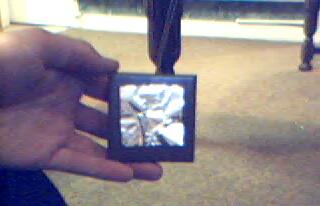

The Trouton-Noble experiment was a test conducted early in the 1900s to determine whther the passage of the Earth through the Ether could be detected using electrical means. In other words, they wanted to demonstrate an electro-etheric interaction.
The method chosen to demonstrate this effect was to hang a charged capacitor in free suspension, and measure any torque produced. The theory was that the capacitor would align itself along the vector of the Ether drift so as to minimise its total energy. In their set-up, Trouton and Noble used a plate glass dielectric, with a thin metal foil covering on either side. Two voltages were used, one about 800 Volts, the other about 1.6kV. Since no torque was produced, Trouton and Noble deduced that the ether was nonexistent, and other theories grew from there.
Later, Thomas Townsend Brown would experiment with High-Voltage capacitors and movement without apparent cause, very much in line with the Ether experiments. He found that his gravitators would move independent of any other source of motion. Since nothing can truly move without influencing something as a reaction mass, perhaps Ether is the missing link to explain Brown's motion. In any case, this experiment has been repeated since that time by Jean-Louis Naudin and Patrick Cornille, with positive results. Here is my replication.....
The Cornille-Naudin replication used what appeared to be a glass or perspex plate, and a voltage in the range of about 25-30kV. When the voltage was applied, the hanging capacitor turned approximatel ninety degrees until it came to rest and stayed there. When the power was removed, it returned gently to the original position. My adaptation uses a slightly different setup.

I have used a ceramic tile as my dielectric, as ceramics seem (after a little testing) to hold high voltage charges better than glass or plastic. The tile is small, about the size of a small beer mat. I applied foil squares to both sides of the tile, and suspended it so that it could rotate freely. There were two wires to apply and carry off the charge, but they do not impede any movcement which may occur. I applied 2 different voltages to the tile and observed the results. These are 44 and 66 kiloVolts. The current is no greater than 10 microamperes. The tiles themselves are made of glazed earthenware, and measure 7cm x 7cm sqaure, and 0.5cm thick.

The results were as follows
44 kiloVolts: A few moments after the potential was applied, the tile began to turn clockwise until it came to rest after approximately 8 seconds of turning. It remained there as long as the potential was applied. However, owing to the excellent charge-storing abilities of the dielectric, it remained in the new position for over 20 seconds. When I manually discharged it, it returned almost instantly to its original state, with a little oscillation caused by the stored torsion n the supporting line.
66 kiloVolts: The effect appeared somewhat faster this time, with the capacitor reaching the same position in slightly less time, perhaps 6 seconds. Once again, the capacitor remained in its position after charging, and returned to rest immediately after it was discharged. This time, I accidentally touched it while charged, and recieved as very painful shock. I would urge everyone attempting any kind of experiment of this type to be extra careful. Even with standard precautions, this one caught me unawares. TAKE CARE!
Conclusions: Something caused a free-hanging charged capacitor to turn, indicating that there is some other kind of interaction going on here than is immediately visible. If the turning of the capacitor denotes the existence of Ether drift, then it appears that the Etherite scientists are vindicated. Most importantly, wires were kept distant and interference minimised to clear out erroneous results. The one thing that can be said with certainty is that the Trouton-Noble experiment can yield a positive effect when performed properly, and that it reveals a novel means of producing torque without any external torque inducing mechanism. The capacitor becomes a statorless electro-etheric motor.